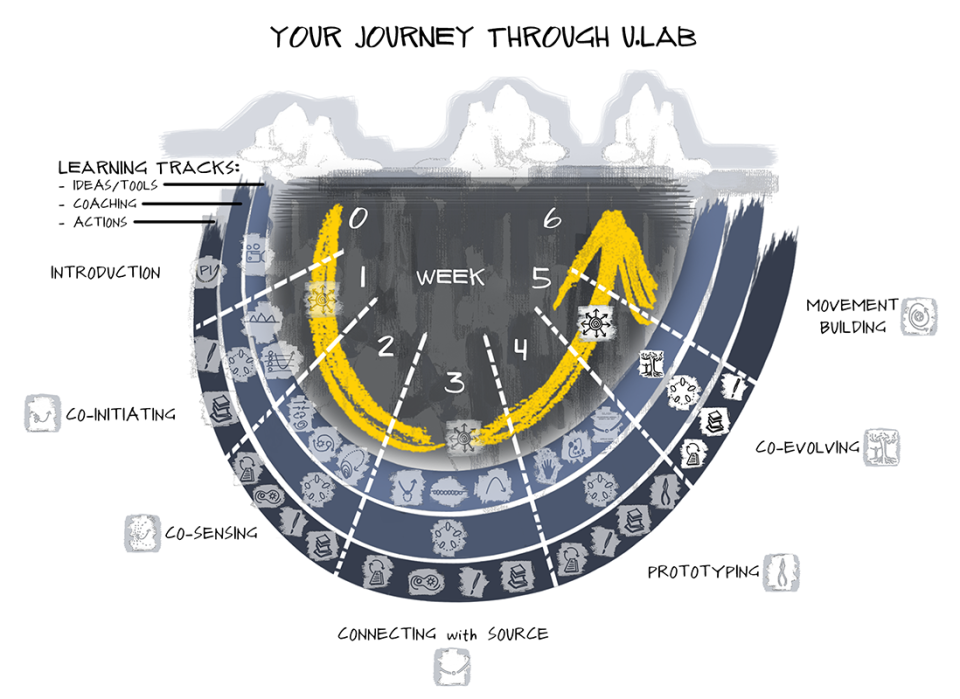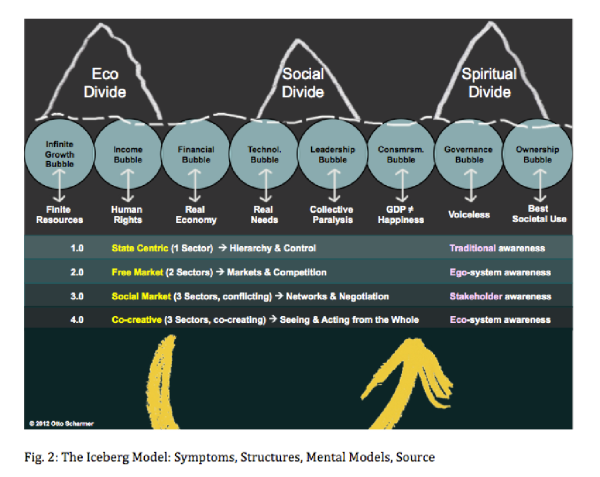Susan E. George*
“Opening the mind, heart and will: from individual awareness to group awareness to societal awareness”
In my previous post on this blog I insisted a lot on the importance of Scharmer and the awareness of the individual, describing in detail the techniques proposed in the MOOC[1] to help us acquire a perception of who we are and of our function within the group.
Another way to describe this process is to call it “opening of the mind, heart and will” (terms used by Scharmer himself to describe the three fundamental stages of the U), but this would not help us to understand the close relationship between individual and collectivity, a complex relationship, which traditionally has been declined and resolved differently in the West and East.
The real (and only) problem of our time, as enunciated by Master Nan (great expert and connoisseur of Taoism, Confucianism, Buddhism consulted by Scharmer and Senge (see previous article) is that of the reconciliation between mind and matter.
The first two levels of listening listed in my previous text are based on the separation of mind and matter, while the latter two levels are based on their integration.
At first glance it may seem to have gone from an economic discourse on overcoming capitalism to a purely philosophical discourse on mind and matter, but by examining a very practical case we can see how the dynamics between individuals (micro) and groups (meso) can, according to Scharmer’s view, solve problems at even higher levels (macro, at the level of society, and mundo– at the global level).
A concrete example
A clear example of the changing relationship between individual, group, and institution concerns the social and health care system of a German region. Based on in-depth interviews and dialogues with doctors, patients, and insurers, Scharmer (2009[2]) and his colleagues discover that there are 4 types (there are always 4!) of relationships between doctors and patients. The interviewees, reconvened over a weekend at the end of the survey to discuss these levels, confirm that the current system of which they are a part stops at only the first two, but that each of them would like to see the system work at levels 3 and 4 (see previous article).
The urgent question then becomes “How do we get to the deeper levels in a context of limited time and financial resources?” But at that point in the debate an impasse is reached as each group loses its overview and returns to its own needs, especially the doctors who, compactly, assert that they are overworked and absolutely cannot give more. At this point, however, a patient turns to them, asking, “Tell us what we need to do to help you!” This woman’s ability to see their problem (level 3 listening: see previous article) completely dissolves the doctors’ reservations, changing the atmosphere in a tangible way. From that moment on, doctors, patients, and insurers come together in search of solutions to some thorny problems. The first solution arrives: the reorganization of emergency management in the hospital, replacing telephone operators who answer emergency calls with doctors. This saves money because doctors are able to distinguish between calls that require an ambulance for admission to the hospital and those that can be met in a less costly manner. What’s amazing about this case is how the enthusiasm of a community learning to co-manage problems generates other solutions and enables the activation of numerous other projects considered cutting edge by other health systems. How did Scharmer’s team go about helping the bodies and minds of the participants come together in a project for the common good?
- by listening to the needs of the various actors,
- by openly confronting these needs,
- with one patient’s particularly empathic listening to the doctors’ problems
- with the consistent response of the whole group to this different level of awareness (“I am you and you are me”)
These stories may seem like science fiction, but can instead be considered an emerging new form of science.
Scharmer meticulously describes eight themes, corresponding to negative trends and problems in the contemporary society, what he calls the “eight bubbles”: infinite growth, income, finance, technology, leadership, consumption, governance, property, which underlie the three disconnections of humans with Nature, with others, and between self and Self. To each of the eight bubbles he metaphorically counters an “acupuncture point” that can act as a cure, bringing the individuals back to know themselves and their relationship with the Source, with others, and with Nature.
In the end, tout se tient if one is able to undertake a new collective journey towards a different awareness, understanding what is the place of each of us, together with other people, in the world.
By following the right side of the U, one does in fact get to propose concrete actions and create a new sense of community, just as they did in Germany in the case cited above.
This is by no means an easy task given the fragmentation of knowledge and the prevailing individualism of today, but we ourselves realize how this individualism is often accompanied by a growing sense of loneliness and a latent desire to find others. Entering into a different paradigm from the prevailing one, one that urges individuals to share, to work, to create together, thus becomes possible when the barriers of fear, cynicism, and concern for the judgment of others are broken down.
The MOOC offers some suggestions on how to do so. Together.
I apologize if these notes sound like an uncritical condoning of the the work of the Presencing Institute. The truth is that the course and the book have blown me away and compelled a certain transformation. For this reason, I will be re-subscribing to the course in September, hoping to perhaps meet you there, maybe in a coaching circle?! (See previous article), although I confess that this time I would love to meet other people from seemingly exotic places….
* Susan E. George “English, Celtic, Neapolitan. A diviner and theatrical performer who has forgotten her past as a university professor and president of the graduate program in Public, Social and Business Communication at the University of Pisa. Fascinated by the importance of dialogical modalities (also the subject of her research) in the creation of organizations willing to learn by learning“.
[1] MOOC = Massive Open Online Course
[2] Scharmer, C. O., 2009, Theory U, Berrett-Koehler Publishers, Inc, San Francisco


